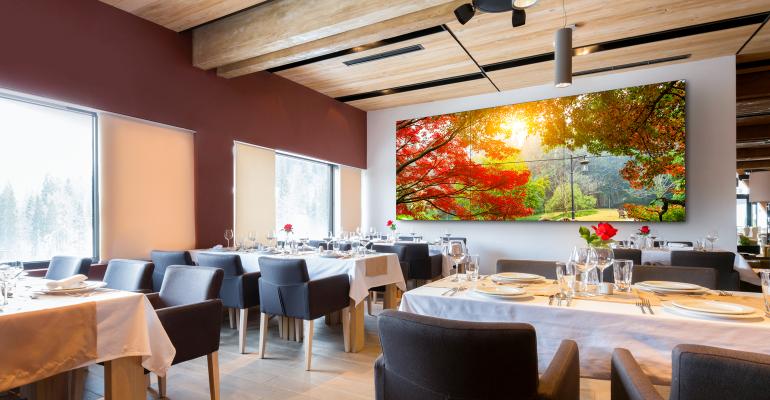Sponsored by NEC Display Solutions
Digital signage can do much more than just show customers what’s on the menu. Larger format screens, such as those used for murals and video walls, can do everything from entertain guests to boost incremental sales.
The key is to invest not only in state-of-the-art technology that displays video and other visuals in a large format, but also to choose high-resolution, engaging content.
“If operators think about all the money they’re spending upfront to buy the hardware, and consider the ways they can use that expenditure in their AV, the better the return on investment,” says Aaron Rees, chief executive and innovator of Chicago-based Moving Murals. The company provides content for video walls and multi-screen murals in restaurants, hotels and other establishments. “We envision it as a canvas for artwork, creating a memorable experience that obviously improves the bottom line overall.”
Operators can implement these video walls and murals to enhance the dining out experience and also generate more revenue. For example, Rees says, a restaurant that often has customers waiting for a table can position screens with moving images in the waiting area to make that time more enjoyable.
A bar or lounge that wants patrons to visit longer and order more drinks can set up a screen with content that encourages more guest interaction and engagement. A restaurant that partners with other local businesses can sell advertising space to these other noncompeting entities, bringing in more revenue.
The right technology
Moving Murals partners with Itasca, Ill.-based NEC Display Solutions of America, Inc., which makes commercial and professional-grade display screens and integrated solutions. NEC and Moving Murals offer Art Channels + Hardware Bundles, which consist of 55-inch, 65-inch, 84-inch or 98-inch NEC screens that display content from the 22 different art channels from Moving Murals, in 4k resolution.
The high resolution is an essential component for showing high-quality content. The operator has to budget for it. “Most video walls are capable of running 4K resolution and beyond, in many cases up to 8K,” Rees says. “The software and content should match that capability.”
It used to be that restaurant guests could watch sports from a cable channel feed, or trivia games or even animated displays of food and beverages. Today consumers expect much more for their entertainment. In addition, these visuals are not high-resolution enough to look impressive on high-quality screens, so operators must rely on videos that are more engaging.
The right content
Nature scenes in a continuous loop are especially popular. A seafood restaurant can display ocean life videos. A romantic or otherwise dimly lit restaurant can show a never-ending fireplace crackling log. The operator can also change the content if the restaurant has theme nights.
Rees points to several examples that go a step further:
- At the front desk at Dollywood in Pigeon Forge, Tenn., a five-screen display shows a video of the Smoky Mountains as the clouds move past and the light changes as the day progresses. The effect is meant to look as if it were a window on an observation deck, in what is a windowless area in the lobby.
- At an Italian restaurant, a “painting” of the Mona Lisa winks at customers.
- In the lobby of the Cosmopolitan Hotel in Las Vegas, 15-foot video walls present a dazzling display of art and high-definition video.
Putting it all together
When deciding where to set up the video wall, the operator must first think about what are the goals of the video or mural. The operator might want customers to be distracted enough not to notice a bottleneck in the speed of service, but not to be so mesmerized that they linger at their table for too long while other guests are waiting to be seated. For that reason, the video walls should not be located in the main dining room.
The display can even be located outside. For example, Dunkin’ Donuts, in its next-generation unit in Corona, Calif., installed digital displays on its drive-thru menu boards, presenting appealing images of the food and drink, highlighting the current promotions.
The key is to be strategic with the video wall implementation. “If the viewer is engaged with the visual feature, all embedded messaging in the form of marketing and advertising will become that much more effective, thus increasing the ROI of the overall investment,” Rees says. “The best way to think about the overall system design is in terms of creating a bold fusion of art and technology.”



